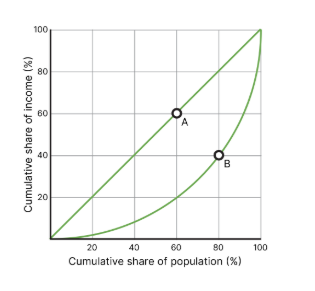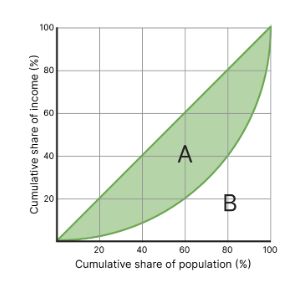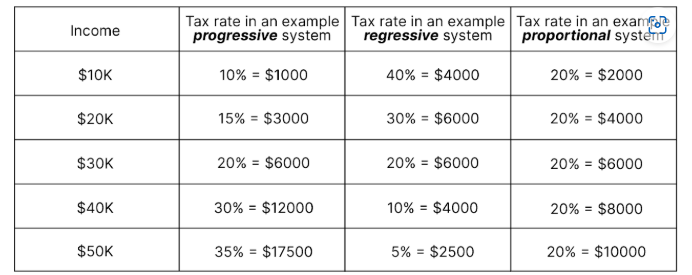ib econ- 3.4: inequality and poverty
1/17
Earn XP
Description and Tags
credits https://www.econinja.net/macroeconomics/3-4-inequality-and-poverty
Name | Mastery | Learn | Test | Matching | Spaced |
|---|
No study sessions yet.
18 Terms
what is the relationship between equality and equity?
equity means economic fairness: in other words - people who work harder jobs that require more skills earn a higher wage in order to incentivise work
this creates inequalities, as some will earn more than others
equality on the other hand, means everyone earns the same amount, so no inequalities exist.
what are the two types of economic inequality?
unequal distribution of income: inequalities present in people’s income in a society
unequal distribution of wealth: inequalities present in people’s wealth in a society
what is a lorenz curve and how does it work?
represents the inequality of income in a country by showing hoe much income certain percentage of the population have
Point A is on the linear curve, a country where everyone earns the same amount. At point A, the bottom 60% of the population make 60% of the country's income.
Point B is on the exponential curve, a country where some earn more than others. At point B, the bottom 80% of the population make 40% of the country's income.

what is the gini coefficient? how is it calculated?
a value that measures income or wealth inequality, in a value ranging from 0 (perfect equality) to 1 (perfect inequality) using the lorenz curve
it does this by finding the area between the perfect equality line and the country’s actual line
the formula is A/(A+B)

what is poverty (absolute and relative)?
an economic condition of being extremely poor and unable to meet basic needs'
absolute poverty: unable to access basic human needs such as food and shelter
relative poverty: unable to reach a specified level of income (usually 50% of a countries’ average earnings)
what are two examples of a single indicator of measuring poverty?
international poverty lines: minimum threshold of income people must meet to have access to basic human needs - currently at $1.90/day - does not take infrastructure into account and is too low for wealth countries
minimum income standards: a minimum income needed for what members of the public think is an acceptable living standard
what is an example of a composite indicator of measuring poverty?
multidimensional poverty index: an index that tracks many components of poverty such as health, education and standards of living. it offers a more thorough indication of poverty
what are the difficulties in measuring poverty?
relative poverty is quite subjective
poverty is a multidimensional issue, to single indicators can be misrepresentative
the international poverty line does not account for purchasing power parity
what are the causes of poverty?
inequality of opportunity: some have less access to opportunities than others, leading to less economic prosperity
different levels of resource ownership
different levels of human capital: some people accumulate more skills, knowledge and experience
discrimination
unequal status and power
government tax and benefits policies: indirect taxes primarily affect the poor, and tax breaks for the rich makes things more unequal
globalisation and technological change: can lead to structural unemployment
market based supply side policies: they aim to remove regulations to make markets more efficient, but they generally leave poor people worse off
what is the effect of inequality on economic growth?
on one hand, it could incentivise hard work and good education, which increases aggregate supply
it could also lead to dissatisfaction, protests and more government money spent on transfer payments to the poor. may also disincentivise entrepreneurship, as small firms cannot compete with large multinational companies
what is the effect of inequalities of standards of living and social stability?
standards of living will improve more for rich people and less for the poor, exacerbating inequalities
more equal countries like the Nordics have low crime rates and higher rates of trust and respect
less equality generally leads to more unrest and violence
what are the three types of taxes?
progressive taxes: the more you earn, the higher of a percentage you will pay as taxes
regressive taxes: the more you earn, the lower of a percentage you will pay as taxes
proportional: everyone pays the same tax rates

what is a direct tax?
taxes imposed on income rather than expenditure (indirect)
what are the three types of direct taxes?
personal taxes
corporate income taxes
wealth taxes (taxes on assets or capital gains) - affects rich people more
are direct taxes fair? what happens when governments overtax?
relatively fair way to redistribute wealth
overtaxing leads to households and firms avoiding taxes, and hard work is disincentivised
why can indirect taxes be more effective?
harder to avoid, and wealthier people may consume more, generating more tax revenue
why can indirect taxes be inequitable?
arguably a form of regressive tax (poorer people end up spending a higher proportion of their income on taxed goods than a wealthier person)
what are some examples of other policies to reduce poverty, and income and wealth inequality?
reduce inequalities of opportunity/investment in human capital: give everyone the same access to education
transfer payments: give out money or other resources (food banks) to those who need it
targeted spending on goods and services: the government could invest in education or healthcare to increase their quality
universal basic income (ubi): give everyone a guaranteed monthly income - whilst this could eliminate poverty, it would raise inflation and increase government debt
policies to reduce discrimination
minimum wages: raises labour costs, decreasing as